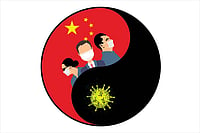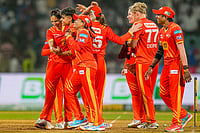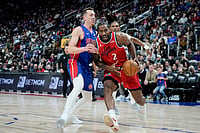If anything other than the mystically picturesque Mount Fuji—or Fuji-San, as the Japanese call it—personifies Japan, it has to be Sumo wrestling. It not only has been the most popular sport in Japan for centuries, but is also a prominent and significant cultural heritage. I have been fascinated by photographs of those towering, monstrously flabby but innocuous-looking wrestlers or rikishi with their trademark topknot or chonmage. Watching those fubsy grapplers in signature loincloth in action with their elephantine movements was on my long-time wishlist. That was fulfilled during my recent sojourn in Japan for the ongoing Rugby World Cup, as my itinerary coincided with the Grand Tournament.
The September edition was the penultimate of the six Grand Tournaments staged in each of the odd months and was the final event of the year in Ryogoku, the cradle of Sumo in Tokyo. Surrounded by many premier Sumo stables or heya, the iconic Kokugikan or the Sumo hall has been the nursery of the 1500-year-old Edo-era sport and its most hallowed arena. I was welcomed at the bustling stadium, abuzz with hundreds of enthusiastic spectators and decorated with colourful banners, splashed with Japanese kanji characters. At the centre of the arena was the wrestling circle, the dohyo—a 2 feet-high raised arena 18 sq ft in dimension. It was spectacular to see a stadium crammed to the rafters cheering for the participating wrestlers as they emerged inside the ring, located under a roof that was suspended from the ceiling by cables and resembled a Shinto shrine with four gigantic tassels hanging from each corner to signify the four seasons.
Before the start of each bout, a colourfully-dressed referee or gyoji walked into the ring and read out the names of the two wrestlers in a musical chant, who would proceed to lock horns. Each lyrical invitation call was followed by lumbering entry by the two silk loincloth or mawashi-wearing wrestlers. Interestingly, apart from the 10 yards long and 2 feet wide heavy silk loincloth, they are not allowed to wear anything else; a wardrobe malfunction during a bout automatically disqualifies the wrestler.
Notably, warm-up rituals were much longer than the actual bouts, with a variety of ceremonial contortions and skilful manoeuvres on display. First, the wrestlers slowly lifted their arms to show that they were unarmed, then lifted their legs high in the air and stomped them down in slow motion as per the Shinto practice of scaring away the demons.
They also rinsed the mouth with water and wiped the body with paper towels to cleanse body and mind. However, one of the key pre-bout rituals was shiomaki—each wrestler sprinkled a handful of salt into the ring to purify it, as it’s believed that salt protects a wrestler from injuries.
Wrestlers adopt a common strategy to psyche out opponents. A wrestler would suddenly get up and go back to their corner from his crouching stance seconds before the start of a bout. Although these ‘mind game’ dummies lingered for a few minutes at times, once a bout got underway it was over in a few seconds. Most of those were over even before I could bat an eyelid; the longest ones, dragging beyond 10 seconds to 20 long seconds, received rapturous cheer.
The winning rule was quite simple. A wrestler was declared the winner if he pushed his rival out of the ring or if any part of his opponent’s body other than the bottom of his feet touched the ground.
Interestingly, staying on two feet inside the ring is the most important factor in Sumo and thus, a wrestler would only eat chicken in Chankonabe—a special diet served during sumo tournaments—as they are believed to always be on two legs like a chicken, not all fours.
As the afternoon progressed, one after another higher-ranked wrestlers took up the challenge from their equally corpulent opponents. Interestingly, the higher the ranking of a wrestler, there was a longer sponsorship parade comprising more men holding flag-like banners with different brand names walking around the inner edges of the ring. It invited a louder cheer from the spectators.
There are seventy winning tricks at the disposal of a sumo wrestler but a handful was on display. Once the day’s final bout was over, there was the much-anticipated grand entry of the highest-ranked sumo wrestler or the Yokozuna. A number of rituals were performed by the behemoth-like Grand Champion, whose exalted status doesn’t get affected by his form or win-loss records. The climax was the edge-of-the-seat Bow Twirling Ceremony by the Yokozuna that brought down the curtain for the day. An item from my bucket list was thus ticked off.
























